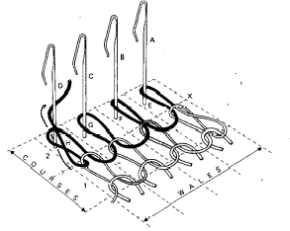Weft vs. Warp Knitting
| Weft |
Warp |
 |
 |
Weft knitting. Weft knitting uses one continuous yarn to form courses, or rows of loops, across a fabric. There are three fundamental stitches in weft knitting: plain-knit,
purl and rib. On a machine, the individual yarn is fed to one or more needles at a time. Weft knitting machines can produce both flat and circular fabric. Circular machines produce mainly yardage but may also produce sweater bodies,
pantyhose and socks. Flatbed machines knit full garments and operate at much slower speeds. The simplest, most common filling knit fabric is single jersey. Double knits are made on machines with two sets of needles. All hosiery is produced as a filling knit process.
Warp Knitting. Warp knitting represents the fastest method of producing fabric from yarns. Warp knitting differs from weft knitting in that each needle loops its own thread. The needles produce parallel rows of loops simultaneously that are interlocked in a zigzag pattern. Fabric is produced in sheet or flat form using one or more sets of warp yarns. The yarns are fed from warp beams to a row of needles extending across the width of the machine (Figure 9b). Two common types of warp knitting machines are the Tricot and Raschel machines. Raschel machines are useful because they can process all yarn types in all forms (filament, staple, combed, carded, etc.). Warp knitting can also be used to make pile fabrics often used for upholstery.
Back



